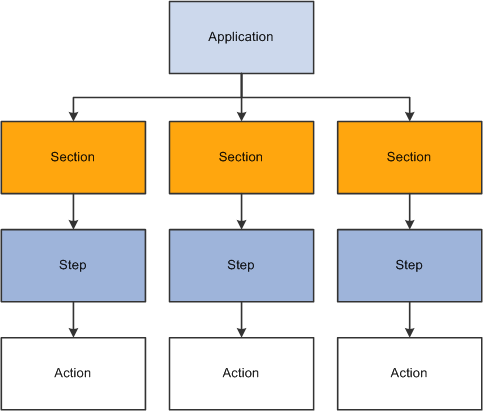 PeopleSoft Enterprise Application Engine Overview
PeopleSoft Enterprise Application Engine Overview
This chapter provides an overview of PeopleSoft Enterprise Application Engine and discusses:
Application Engine implementation.
Other sources of information.
 PeopleSoft Enterprise Application Engine Overview
PeopleSoft Enterprise Application Engine Overview
Application Engine is a PeopleTool designed to help you develop background SQL processing programs. This tool is intended to be used by developers with knowledge of SQL, SQL tools, and PeopleTools.
Application Engine offers an alternative to writing COBOL or SQR programs for background SQL processing. While Application Engine does not generate, parse, or understand SQL, it does execute SQL that you provide.
This diagram shows the program structure of Application Engine:

Application Engine program structure
 PeopleSoft Enterprise Application Engine Implementation
PeopleSoft Enterprise Application Engine Implementation
This section provides information to consider before you begin to use Application Engine.
Implementation of Application Engine can be divided into these activities:
Set up properties.
Specify actions.
Create temporary table instances.
Set up debugging options.
Enable Application Engine tracing.
To set up Application Engine properties, perform these steps:
|
Step |
Reference |
|
1. Set up program properties. |
|
|
2. Set up section properties. |
|
|
3. Set up step properties. |
|
|
4. Set up action properties. |
To modify action properties, perform these steps:
|
Step |
Reference |
|
1. Specify SQL actions. |
|
|
2. Specify Do actions. |
|
|
3. Specify PeopleCode actions. |
|
|
4. Specify Call Section actions. |
|
|
5. Specify Log Message actions. |
Creating Temporary Table Instances
To set up temporary tables to improve performance, perform these steps:
|
Step |
Reference |
|
1. Define temporary tables. |
|
|
2. Set up the number of temporary table instances. |
|
|
3. Build table instances. |
To set up debugging options for Application Engine programs, perform these steps:
|
Step |
Reference |
|
1. Enable the Application Engine debugger. |
|
|
2. Set up debugging options. |
Enabling Application Engine Tracing
To trace Application Engine programs, perform these steps:
|
Step |
Reference |
|
1. Set command line options. |
|
|
2. Set parameters in server configuration files. |
|
|
3. Set options in Configuration Manager. |
Other Sources of Information
In addition to implementation considerations presented in this chapter, take advantage of all PeopleSoft sources of information, including the installation guides, release notes, and PeopleBooks.
See Also
Oracle's PeopleSoft Application Engine Preface
PeopleTools 8.52: Getting Started with PeopleTools